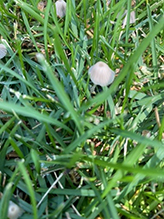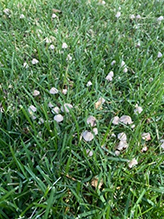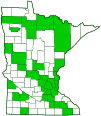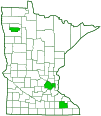White Dunce Cap
(Conocybe apala var. albipes)
Conservation • Description • Habitat • Ecology • Distribution • Taxonomy
|
|
||||||||||||||
Description |
White Dunce Cap is a small, ephemeral, conecap mushroom. It occurs in Europe and North America. In the United States, it occurs east of the Great Plains and west of the Rocky Mountains, with just a few scattered records between. There are two varieties of Conocybe apala. Conocybe apala var. albipes is the most widespread form, and it may be the only variety in North America. If that is the case, then it is widespread across the United States. White Dunce Cap is found in summer and fall in open, sunny, grassy places. It is common in yards, parks, pastures, baseball fields, and other places with mowed lawns. It appears alone, scattered, or in groups but not clustered (gregarious). It grows on the ground, on clumps of dead grass, in wood chips, and in compost. It is especially common in muggy weather. It is short-lived, appearing early in the morning then toppling over and shriveling up by the afternoon. When it first appears, the cap is narrowly cone shaped, whitish, hairless, and unlined. As it ages it broadens and the color changes to buff or pale cinnamon. The mature cap is ⅜″ to 1″ long and (1.0 to 2.5 cm) wide. It is usually broadly cone shaped, sometimes bell shaped with the margins flared outward. It is always about as tall as wide – it never becomes broader or flattens out. The surface is dry. It is finely lined at the margins, and it may be darker in the center The stalk is thin, hollow, ⅜″ to 4¼″ (3 to 11 cm) long, and 1⁄32″to ⅛″ (1 to 3 mm) thick. It is swollen at the base, but otherwise equal in thickness from top to bottom. It is white or whitish, sometimes becoming yellowish near the base. It is extremely fragile, making it difficult to collect without breaking. The gills are closely spaced or crowded. They may be narrowly attached to the stalk or unattached (free). Between the main gills there are short gills that do not extend to the stalk. The gills are pale at first, soon becoming cinnamon brown or brown as the spores mature. They often liquefy in hot humid weather. The flesh is thin and insubstantial. It is not edible, and there is little there to eat. The spore print is cinnamon brown. |
Similar Species |
Habitat and Hosts |
|
Ecology |
Season |
Summer |
Distribution |
||||||||||||||||||||||
|
||||||||||||||||||||||
Occurrence |
||||||||||||||||||||||
Common |
||||||||||||||||||||||
Taxonomy |
|
Kingdom |
Fungi (Fungi) |
Subkingdom |
Dikarya |
Phylum |
Basidiomycota (Basidiomycete Fungi) |
Subphylum |
Agaricomycotina (Higher Basidiomycetes) |
Class |
Agaricomycetes (Mushrooms, Bracket Fungi, Puffballs, and Allies) |
Subclass |
Agaricomycetidae |
Order |
|
Suborder |
Agaricineae |
Family |
Bolbitiaceae |
Genus |
Conocybe (conecaps) |
Section |
Pilosellae |
Species |
Conocybe apala (Milky Conecap) |
|
|
There are two varieties of Conocybe apala. Conocybe apala var. albipes has a cap that is cone shaped or bell shaped, is always higher than wide, and does not expand significantly in age. It is the most widespread form, and it may be the only variety in North America. Conocybe apala var. apala has a cap that is hemispherical to convex, and that expands with age, becoming broader than high. There is a single unverified record of this variety in North America. Not all sources recognize the varieties, and most North American records are identified only to the species level. |
|
Subordinate Taxa |
|
|
|
Synonyms |
|
Conocybe albipes Conocybe albipes albipes Conocybe lactea |
|
Common Names |
|
White Dunce Cap White Dunce Cap Nushroom |
|
Glossary
Saprobic
A term often used for saprotrophic fungi. Referring to fungi that obtain their nutrients from decayed organic matter.
Visitor Photos |
||
Share your photo of this fungus. |
||
This button not working for you? |
||
Deb Wech |
||
 |
 |
|
 |
||
MinnesotaSeasons.com Photos |
||
|
||
|
||

Slideshows |
|

Visitor Videos |
||
Share your video of this fungus. |
||
This button not working for you? |
||
|
Other Videos |
||
Conocybe Apala |
About
May 21, 2017 |
Conocybe apala, Conocybe lactea, Conocybe albipes, the White Dunce Cap, field mushroom |
About
May 6, 2019 I go through the forests, mountains, hills, fields, and waters to understand the living world and to create a living mind. Conocybe apala, Conocybe lactea, Conocybe albipes, the White Dunce Cap, field mushroom. While it has not caused deaths, it is toxic, containing phallotoxins. |
Conocybe apala "white dunce cap" |
About
Jun 8, 2022 Gainesville, FL early morning, University of Florida campus |

Visitor Sightings |
||
Report a sighting of this fungus. |
||
This button not working for you? |
||
|
|
MinnesotaSeasons.com Sightings |
||
|

|
Created: 7/6/2024 Last Updated: © MinnesotaSeasons.com. All rights reserved. |

